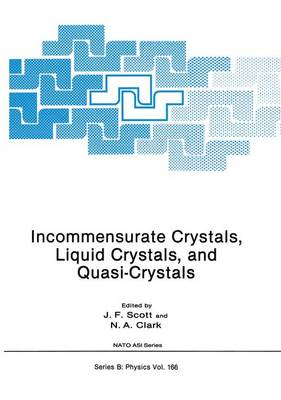NATO Science Series B
1 primary work
Book 166
Incommensurate Crystals, Liquid Crystals, and Quasi-Crystals
by J F Scott and N. A. Clark
Published 1 January 1988
In this NATO-sponsored Advanced Research Workshop we succeeded in bringing together approximately forty scientists working in the three main areas of structurally incommensurate materials: incommensurate crystals (primarily ferroelectric insulators), incommensurate liquid crystals, and metallic quasi-crystals. Although these three classes of materials are quite distinct, the commonality of the physics of the origin and descrip tion of these incommensurate structures is striking and evident in these proceedings. A measure of the success of this conference was the degree to which interaction among the three subgroups occurred; this was facili tated by approximately equal amounts of theory and experiment in the papers presented. We thank the University of Colorado for providing pleasant housing and conference facilities at a modest cost, and we are especially grate ful to Ann Underwood, who retyped all the manuscripts into camera-ready form. J. F. Scott Boulder, Colorado N. A. Clark v CONTENTS PART I: INCOMMENSURATE CRYSTALS A. Theory A PHENOMENOLOGICAL THEORY OF THE TRANSITION SEQUENCE INCLUDING AN INCOMMENSURATE (COMMENSURATE) PHASE SANDWICHED BY REENTRANT COMMENSURATE (INCOMMENSURATE) PHASE - Yoshihiro Ishibashi . . . . . 1 DAUPHINE-TWIN DOMAIN CONFIGURATIONS IN QUARTZ AND ALUMINUM PHOSPHATE - M. B. Wa lker . . . . . . . . . . 9 ELASTIC AND INELASTIC SCATTERING FROM QUASI-PERIODIC STRUCTURES - T. Janssen and R. Currat . . . . . 19 ARE EXOTIC CONSEQUENCES OF INCOMMENSURABILITY IN SOLIDS EXPERIMENTALLY OBSERVABLE? - J. B. Sokoloff. 35 B. Theory - Numerical l1ethods THE APPLICATION OF AXIAL ISING MODELS TO THE DESCRIPTION OF MODULATED ORDER - Julia Yeomans . . 45 TWO-DIMENSIONAL MODELS OF COMMENSURATE-INCOMMENSURATE PHASE TRANSITIONS - Palll D. Beale . . .
